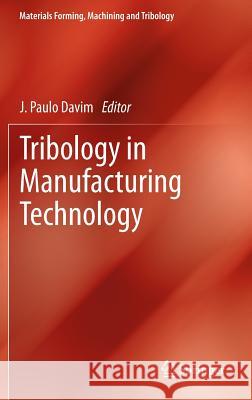Tribology in Manufacturing Technology » książka



Tribology in Manufacturing Technology
ISBN-13: 9783642316821 / Angielski / Twarda / 2012 / 198 str.
Tribology in Manufacturing Technology
ISBN-13: 9783642316821 / Angielski / Twarda / 2012 / 198 str.
(netto: 383,36 VAT: 5%)
Najniższa cena z 30 dni: 385,52
ok. 22 dni roboczych
Dostawa w 2026 r.
Darmowa dostawa!
This book aims to show how tribological concepts can be applied in order to improve manufacturing technology in modern industry. It can be used as a guide book for engineering students or a reference useful for academics in the fields of tribology, manufacturing, materials and mechanical engineering.
Preface
1 Tribology of cutting tools
1.1 What is the tribology of cutting tools?
1.1.1 Tribology of metal cutting
1.1.2 Tribology of cutting tools
1.1.3 Importance of the subject
1.1.4 Why now?
1.2 Underlying principle
1.3 Tribological interfaces: tool-chip interface
1.3.1 Geometry of tool-chip interface
1.3.2 Summary of tribological conditions at the tool chip interface
1.3.3 System consideration
1.3.4 Stress distribution and mean
1.3.5 Temperature
1.3.5.1 Known facts
1.3.5.2 Contradiction
1.3.5.3 Moving chip – the governing equation
1.3.5.4 Summary of temperature consideration
1.3.5.5 Optimal cutting temperature law
1.3.6 Issues to be addressed
1.3.6.1 FEM modeling of contact stress distributions
1.3.6.2 Particularities of stress distribution on the restricted tool-chip contact lenght
1.3.6.3 Influence of cutting speed
1.4 Tribological interfaces: tool-workpiece interface
1.5 Tool wear
1.6 Improvements of tribological conditions of cutting tools
1.6.1 Grades of tool materials
1.6.1.1 Basic properties of tool materials
1.6.1.2 Selection of application specific grade of HSS
1.6.2 Application of the metal working fluid (MWF) through the cutting tool
References
2 Tribology of machining
2.1 Friction interactions in machining
2.2 Cutting, ploughing and sliding interactions (after Jackson and Morrel, 2011)
2.2.1 Static friction and stick-slip phenomena
2.2.2 Sliding friction
2.2.2.1 Models for sliding friction
2.2.3 Friction heating
2.3 Lubrication to control friction in machining (after Jackson and Morrel, 2011)
2.3.1 Liquid lubrification
References
3 Tribology in metal forming processes
3.1 Introduction
3.2 Friction
3.3 Lubrication
3.4 Wear
3.5 Conclusion
References
4 Tribology in hot rolling steel strip
4.1 Introduction
4.2 Structure of oxide scale and oxidation kinetics in pure iron and carbon steel 4.2.1 Pure iron
4.2.2 Carbon steel
4.2.2.1 800°C and above
4.2.2.2 Below 800°C
4.2.3 Structure of oxide scale and oxidation kinetics in stainless steels
4.2.4 Oxidation of stainless steels in moist atmosphere
4.2.5 Oxidation of stainless steels in hot strip rolling
4.3 Mechanical properties and thermal properties of oxide scale
4.3.1 Surface characteristics
4.3.2 Morphology on cross section
4.4 Mechanical properties and thermal properties of the oxide scale
4.4.1 Mechanical properties and measurement methodology
4.4.2 Thermal properties and the effect of oxide scale on heat transfer
4.5 Evolution of oxide scale during hot rolling
4.5.1 Oxide scale growth and deformation during finishing rolling
4.5.2 Oxide scale structures developed on hot rolled steel strip
4.5.3 Deformation and fracture behaviour of oxide scale under hot rolling conditions
4.5.3.1 Carbon steel
4.5.3.2 Stainless steels
4.6 Oxide scale involved surface roughness and its transfer during hot rolling
4.6.1 Carbon steel
4.6.2 Stainless steels
4.6.3 Numerical simulation
4.7 Evaluation of friction in hot rolling and tribological effect of oxide scale
4.7.1 Evaluation of friction in hot rolling
4.7.2 Tribological effect of oxide scale
4.7.2.1 Carbon steel
4.7.2.2 Stainless steels
References
5 Micro-contact at interface between tool and workpiece in metal forming
5.1 Introduction
5.2 Micro-contact under each lubrication
5.2.1 Micro-contact under dry and thin film lubrication
5.2.2 Micro-contact under thick film lubrication
5.2.3 Micro-contact under micro-plasto-hydrodynamic lubrication
5.2.4 Micro-contact under mixed lubrication
5.3 Micro-contact at the interface between tool and workpiece in sheet metal forming
5.3.1 Direct observation of micro-contact.
5.3.2 Lubrication mechanism at interface between tool and workpiece
5.4 Micro-contact at interface between roll and sheet in cold sheet rolling
5.4.1 Inlet oil film thickness
5.4.2 Micro-contact at interface between roll and sheet
5.4.3 Estimation system for micro-contact of roled sheet in stainless steel cold rolling process
5.5 Conclusions
References
6 Coatings and applications
6.1 Introduction
6.2 Plasma nitriding
6.3 Chemical vapor deposition
6.4 Physical vapor deposition
6.4.1 Deposition by vacuum evaporation
6.4.2 Cathode sputtering
6.4.3 Ion plating
6.5 Modern coatings
6.5.1 Multilayer
6.5.2 DLC-diamond-like carbon
6.5.2.1 Process of DLC coating manufacture
6.6 Coating properties
References
J. Paulo Davim received his PhD degree in Mechanical Engineering from the University of Porto in 1997 and the Aggregation from the University of Coimbra in 2005. Between 1986/96, he was lecturer in University of Porto. Currently, he is an Aggregate Professor at the Department of Mechanical Engineering of the University of Aveiro and the Head of MACTRIB - Machining and Tribology Research Group http://www2.mec.ua.pt/machining . He has more 24 years of teaching and research experience in manufacturing, materials and mechanical engineering with special emphasis in Machining & Tribology. He is the Editor in Chief of six international journals, Guest Editor of journals, books Editor, book Series Editor and Scientific Advisory for many international journals and conferences. Presently, he is an Editorial Board member of 15 international journals and acts as reviewer for than 50 prestigious ISI web Science journals. In addition, he has also published as author and co-author more than 30 book chapters and 300 articles in journals and conferences (more 150 articles in ISI Web Science, h-index 17).
The present book aims to provide research advances on tribology in manufacturing technology for modern industry. This book can be used as a research book for final undergraduate engineering course (for example, mechanical, manufacturing, materials, etc) or as a subject on manufacturing at the postgraduate level. Also, this book can serve as a useful reference for academics, manufacturing and tribology researchers, mechanical, mechanical, manufacturing and materials engineers, professionals in related industries with manufacturing and tribology.
1997-2025 DolnySlask.com Agencja Internetowa
KrainaKsiazek.PL - Księgarnia Internetowa









